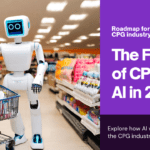The Generative AI landscape presents a wealth of opportunities for medium-scale enterprises aiming to innovate, streamline operations, and lead within their industries. With a projected market exceeding $50 billion by 2028 and a 30% CAGR, embracing Generative AI can redefine product offerings, customer experiences, and operational efficiency. This strategic roadmap outlines five pivotal steps for enterprises to navigate the realm of Generative AI and position themselves as frontrunners in this transformative field.
1. Opportunity Identification and Analysis: Unveiling Potential
Medium-scale enterprises are positioned at a pivotal juncture, ripe for transformative innovation through Generative AI. A meticulous industry landscape analysis presents boundless prospects. In the retail sector, the integration of Generative AI-powered recommendation engines, akin to Amazon’s renowned system, holds immense potential. These engines possess the capability to remarkably amplify customer engagement and drive sales, offering personalized experiences that resonate with consumers.
Similarly, within manufacturing, the adoption of predictive maintenance models powered by Generative AI stands as a beacon of efficiency. These models herald a new era in equipment maintenance, minimizing downtime and curtailing operational costs significantly, thereby enhancing overall productivity.
By delving deep into these opportunities, medium-scale enterprises can harness Generative AI’s potential to revolutionize customer experiences, optimize operational efficiency, and carve out a competitive edge within their industries. This strategic foresight in identifying these niches primes them for leadership in an increasingly innovative landscape driven by AI-powered advancements.
2. Innovation and Implementation Roadmap: Paving the Path
Innovation emerges as the linchpin in the transformative journey of Generative AI adoption for medium-scale enterprises. Crafting a comprehensive roadmap necessitates the initiation of pilot projects or smaller implementations as crucial stepping stones to validate the technology’s potential impact. For instance, industry giants like IBM, with their Watson AI platform, serve as trailblazers in this domain, exemplifying the efficacy of such an approach. Watson’s modular AI solutions stand as a testament to the versatility of Generative AI, offering adaptable frameworks tailored to diverse industries’ needs.
By embracing this roadmap, medium-scale enterprises can pivot towards innovation-centric strategies, validating the potential of Generative AI in addressing industry-specific challenges. These initial forays into smaller implementations act as catalysts, propelling enterprises towards larger-scale adoption. Such strategic maneuvers pave the path for not just understanding but harnessing the full capabilities of Generative AI, positioning these enterprises as frontrunners in the AI-driven landscape of tomorrow.
3. Time-to-Market Optimization: Accelerating Impact
Efficiency stands as the linchpin in unlocking Generative AI’s full potential within medium-scale enterprises. Accelerating impact requires a concerted effort towards streamlining implementation processes. Adopting agile methodologies and embracing cutting-edge cloud-based solutions, exemplified by Google’s AutoML, serve as pivotal enablers. These approaches empower enterprises with the agility to pivot swiftly, fostering quicker iterations and facilitating rapid testing. Ultimately, they culminate in a significant reduction in time-to-market for Generative AI solutions.
By embracing these strategies, medium-scale enterprises can swiftly navigate the complexities of Generative AI integration. The adoption of agile methodologies coupled with innovative cloud-based tools not only expedites the deployment process but also ensures adaptability to evolving market demands. This optimization of time-to-market positions these enterprises on the forefront of innovation, seizing opportunities swiftly and capitalizing on Generative AI’s transformative potential ahead of the competition.
4. Exploitation of Generative AI Benefits: Capitalizing on Advantages
Post-implementation, medium-scale enterprises embark on a continuous journey of monitoring and measuring the efficacy of Generative AI applications. The crux lies in harnessing the manifold advantages offered by Generative AI, heralding a paradigm shift in customer experiences and operational efficiency. This ongoing evaluation ensures optimization and fine-tuning, ensuring the technology aligns seamlessly with enterprise objectives. Notably, the success of Netflix’s recommendation engine, a quintessential example, epitomizes the transformative power of Generative AI in revolutionizing customer engagement and retention.
Leveraging Generative AI’s inherent benefits, including heightened personalization, data-driven decision-making, and streamlined automated processes, medium-scale enterprises usher in a new era of operational excellence. These advancements redefine customer interactions, tailoring experiences to individual preferences and needs. Moreover, they drive internal efficiencies by enabling data-backed decision-making, optimizing workflows, and automating repetitive tasks. This continuous exploitation of Generative AI’s benefits cements these enterprises’ positions as innovators in their industries, setting new benchmarks for customer-centricity and operational efficacy.
5. Re-engineering and Scaling: Sustaining Growth
Constant evolution stands as the cornerstone of sustained growth for medium-scale enterprises adopting Generative AI. Re-engineering existing processes becomes imperative to continually optimize the technology’s impact. As initial successes surface, scaling these applications across various departments or product lines emerges as a strategic necessity. This seamless integration ensures sustained innovation and reinforces the technology’s value across the organization’s ecosystem.
The agile adaptation of Generative AI demands a proactive approach to refine and recalibrate existing processes continuously. This ongoing re-engineering allows medium-scale enterprises to extract maximum value from the technology, leveraging its transformative potential. Furthermore, scaling successful applications across diverse business units or product lines fosters a culture of innovation and efficiency throughout the organization. This unified approach not only ensures a cohesive implementation but also positions the enterprise for sustained growth and leadership in the evolving landscape of Generative AI.
Final Words
Through this strategic approach, medium-scale enterprises can effectively identify opportunities, innovate with Generative AI, optimize time-to-market, exploit its benefits, and continuously re-engineer for sustained leadership in the field, positioning themselves at the forefront of the transformative Generative AI landscape.



